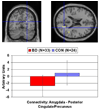Neural connectivity in children with bipolar disorder: impairment in the face emotion processing circuit
- PMID: 18181882
- PMCID: PMC2721276
- DOI: 10.1111/j.1469-7610.2007.01819.x
Neural connectivity in children with bipolar disorder: impairment in the face emotion processing circuit
Abstract
Background: Pediatric bipolar disorder (BD), a highly debilitating illness, is characterized by amygdala abnormalities, i.e., volume reduction and hyperactivation during face processing. Evidence of perturbed amygdala functional connectivity with other brain regions would implicate a distributed neural circuit in the pathophysiology of BD, and would further elucidate the neural mechanisms associated with BD face emotion misinterpretation.
Methods: Thirty-three BD and 24 healthy age, gender, and IQ-matched subjects completed a functional magnetic resonance imaging (fMRI) task of face emotion identification in which attention was directed to emotional (hostility, fearfulness) and nonemotional (nose width) aspects of faces. Voxel-wise analyses examined whole brain functional connectivity with the left amygdala.
Results: Compared to healthy subjects, BD subjects had significantly reduced connectivity between the left amygdala and two regions: right posterior cingulate/precuneus and right fusiform gyrus/parahippocampal gyrus. Deficits were evident regardless of mood state and comorbid diagnoses.
Conclusions: BD youth exhibit deficient connectivity between the amygdala and temporal association cortical regions previously implicated in processing facial expressions and social stimuli. In conjunction with previously documented volumetric and functional perturbations in these brain regions, dysfunction in this distributed neural circuit may begin to clarify the pathophysiology of the face emotion misperceptions and social deficits seen in BD youth.
Conflict of interest statement
Conflict of interest statement: No conflicts declared.
Figures


Similar articles
-
Amygdala activity and prefrontal cortex-amygdala effective connectivity to emerging emotional faces distinguish remitted and depressed mood states in bipolar disorder.Bipolar Disord. 2012 Mar;14(2):162-74. doi: 10.1111/j.1399-5618.2012.00999.x. Bipolar Disord. 2012. PMID: 22420592 Free PMC article.
-
Anomalous prefrontal-limbic activation and connectivity in youth at high-risk for bipolar disorder.J Affect Disord. 2017 Nov;222:7-13. doi: 10.1016/j.jad.2017.05.051. Epub 2017 Jun 23. J Affect Disord. 2017. PMID: 28667891
-
Corticolimbic functional connectivity in adolescents with bipolar disorder.PLoS One. 2012;7(11):e50177. doi: 10.1371/journal.pone.0050177. Epub 2012 Nov 21. PLoS One. 2012. PMID: 23185566 Free PMC article.
-
Neurocognitive correlates of emotional stimulus processing in pediatric bipolar disorder: a review.Postgrad Med. 2010 Jul;122(4):94-104. doi: 10.3810/pgm.2010.07.2177. Postgrad Med. 2010. PMID: 20675973 Review.
-
Cognitive neuroscience and brain imaging in bipolar disorder.Dialogues Clin Neurosci. 2008;10(2):153-63. doi: 10.31887/DCNS.2008.10.2/lclark. Dialogues Clin Neurosci. 2008. PMID: 18689286 Free PMC article. Review.
Cited by
-
Neurofunctional Correlates of Response to Quetiapine in Adolescents with Bipolar Depression.J Child Adolesc Psychopharmacol. 2018 Jul/Aug;28(6):379-386. doi: 10.1089/cap.2017.0030. Epub 2018 May 30. J Child Adolesc Psychopharmacol. 2018. PMID: 29847157 Free PMC article. Clinical Trial.
-
Limbic changes identified by imaging in bipolar patients.Curr Psychiatry Rep. 2008 Dec;10(6):505-9. doi: 10.1007/s11920-008-0080-8. Curr Psychiatry Rep. 2008. PMID: 18980734 Review.
-
Amygdala functional connectivity predicts pharmacotherapy outcome in pediatric bipolar disorder.Brain Connect. 2011;1(5):411-22. doi: 10.1089/brain.2011.0035. Epub 2011 Dec 7. Brain Connect. 2011. PMID: 22432455 Free PMC article.
-
Olfactocentric paralimbic cortex morphology in adolescents with bipolar disorder.Brain. 2011 Jul;134(Pt 7):2005-12. doi: 10.1093/brain/awr124. Epub 2011 Jun 11. Brain. 2011. PMID: 21666263 Free PMC article.
-
Aberrant amygdala intrinsic functional connectivity distinguishes youths with bipolar disorder from those with severe mood dysregulation.Psychiatry Res. 2015 Feb 28;231(2):120-5. doi: 10.1016/j.pscychresns.2014.11.006. Epub 2014 Nov 20. Psychiatry Res. 2015. PMID: 25544024 Free PMC article.
References
-
- Altshuler LL, Bartzokis G, Grieder T, Curran J, Jimenez T, Leight K, Wilkins J, Gerner R, Mintz J. An MRI study of temporal lobe structures in men with bipolar disorder or schizophrenia. Biological Psychiatry. 2000;48:147–162. - PubMed
-
- Amaral D, Price JL, Pitaken A, Carmichael S. In: The amygdala: Neurobiological aspects of emotion, memory and mental dysfunction. Aggleton JP, editor. New York: Wiley-Liss; 1992. pp. 1–66.
-
- American Psychiatric Association. Diagnostic and statistical manual of mental disorders. Washington, DC: American Psychiatric Press; 1994.
-
- Blumberg HP, Fredericks C, Wang F, Kalmar JH, Spencer L, Papademetris X, Pittman B, Martin A, Peterson BS, Fulbright RK, Krystal JH. Preliminary evidence for persistent abnormalities in amygdala volumes in adolescents and young adults with bipolar disorder. Bipolar Disorder. 2005;7:570–576. - PMC - PubMed

